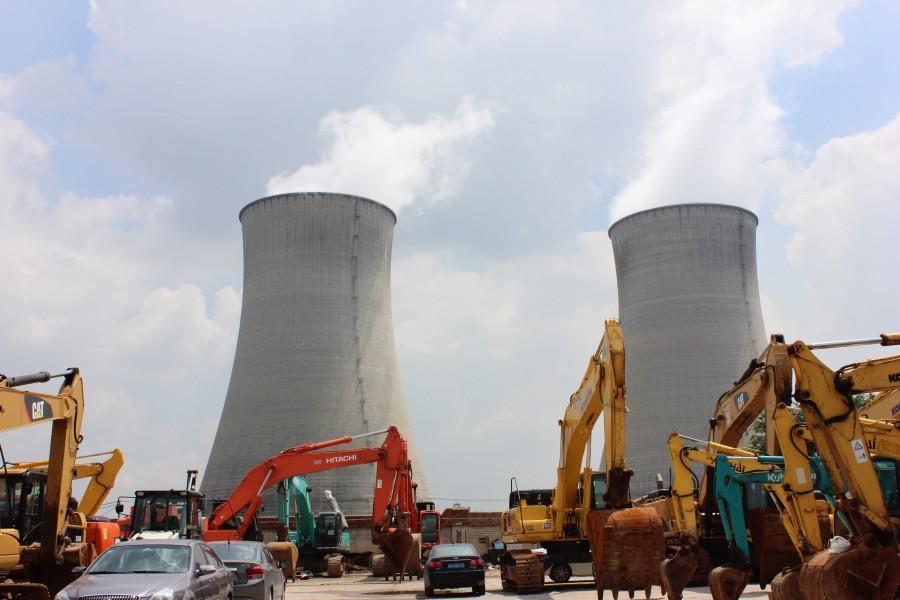Obama announces Clean Power Plan
The Wujing coal-fired power plant in Shanghai emits harmful carbon dioxide into the air. Obama’s Clean Power Plan aims to reduce the amount of greenhouse gas emissions by 32 percent by 2030.
President Obama’s finalized Clean Power Plan was released to the public at a White House press conference on Aug. 3. The plan aims to reduce the amount of greenhouse gas emissions by 32 percent from levels in 2005 over the course of the next 15 years.
The Environmental Protection Agency (EPA) will give each state an individual carbon emissions reduction goal based upon the different mix of electricity-producing sources each state uses. With the final set of rules, states retain flexibility for their reduction programs.
Power plants are the main source of carbon dioxide emissions, and coal-fired ones emit the most amount of harmful gas into the atmosphere. Obama’s plan also seeks to rely more on renewable energy than natural gas-supplied power plants.
California also took its own action in helping with climate change by beginning a market-based cap-and-trade program as well as helping deduce the amount of carbon pollution from power sectors by 8 percent. The EPA’s goal for California is to make electricity sales from renewable energy reach 33 percent by 2020 and to reduce energy consumption by 10 percent within 10 years.
There are mixed feelings on this plan. “Not only will these massive regulations fail to meaningfully effect the global climate, they could actually end up harming the environment by outsourcing energy production in countries with poor environmental records…so I’m not going to sit by while the White House takes aims at the light blood of our state’s economy, I’m going to keep doing everything I can to fight them,” said senior senator of Kentucky, Mitch McConnell, in a video regarding Obama’s Clean Power Plan. Currently, 15 states have filed for the stay on the Clean Power plan.
What is Climate Change and how does it affect us?
Climate change affects people of all ages, ethnicities and countries. It harms not only the earth itself but also our bodies and health. Earth’s temperature rose 1.4º F over the past 135 years.
According to National Oceanic and Atmospheric Administration (NOAA), 2014 was the hottest year on record, and the 10 most scalding years world-wide have all occurred within the past 17 years.
As sea levels rise and oceans become warmer, glaciers are melting faster and drought seasons are becoming longer.
According to a new National Aeronautics and Space Administration (NASA) study, California had only 20 inches of precipitation between 2012 and 2015, equivalent to the average amount of rain expected to fall in a state in a single year. There have been a total of about 3,600 fires in California this year, which is about three times as much as usual. Lightning storms have fueled these fires, as well as the lack of rain and harsh weather patterns. Thousands of people from different parts of California have been evacuated from their homes, and residents in the Bay Area have also been smelling and seeing smoke coming from the mountains, which fire officials say are caused from the fires burning in Northern California.
Changes have also occurred around us in support of fighting against global warming such as stores no longer supplying free plastic bags, as well as electric cars and carpool lanes being used to encourage people to lessen the amount of gas fumes emitted into the atmosphere by cars.

Ashley Jiang (11) is the photo editor for Winged Post. This is her third year in the journalism program, and she was a reporter her freshman and sophomore...




![LALC Vice President of External Affairs Raeanne Li (11) explains the International Phonetic Alphabet to attendees. "We decided to have more fun topics this year instead of just talking about the same things every year so our older members can also [enjoy],” Raeanne said.](https://harkeraquila.com/wp-content/uploads/2025/10/DSC_4627-1200x795.jpg)


















![“[Building nerf blasters] became this outlet of creativity for me that hasn't been matched by anything else. The process [of] making a build complete to your desire is such a painstakingly difficult process, but I've had to learn from [the skills needed from] soldering to proper painting. There's so many different options for everything, if you think about it, it exists. The best part is [that] if it doesn't exist, you can build it yourself," Ishaan Parate said.](https://harkeraquila.com/wp-content/uploads/2022/08/DSC_8149-900x604.jpg)




![“When I came into high school, I was ready to be a follower. But DECA was a game changer for me. It helped me overcome my fear of public speaking, and it's played such a major role in who I've become today. To be able to successfully lead a chapter of 150 students, an officer team and be one of the upperclassmen I once really admired is something I'm [really] proud of,” Anvitha Tummala ('21) said.](https://harkeraquila.com/wp-content/uploads/2021/07/Screen-Shot-2021-07-25-at-9.50.05-AM-900x594.png)







![“I think getting up in the morning and having a sense of purpose [is exciting]. I think without a certain amount of drive, life is kind of obsolete and mundane, and I think having that every single day is what makes each day unique and kind of makes life exciting,” Neymika Jain (12) said.](https://harkeraquila.com/wp-content/uploads/2017/06/Screen-Shot-2017-06-03-at-4.54.16-PM.png)








![“My slogan is ‘slow feet, don’t eat, and I’m hungry.’ You need to run fast to get where you are–you aren't going to get those championships if you aren't fast,” Angel Cervantes (12) said. “I want to do well in school on my tests and in track and win championships for my team. I live by that, [and] I can do that anywhere: in the classroom or on the field.”](https://harkeraquila.com/wp-content/uploads/2018/06/DSC5146-900x601.jpg)
![“[Volleyball has] taught me how to fall correctly, and another thing it taught is that you don’t have to be the best at something to be good at it. If you just hit the ball in a smart way, then it still scores points and you’re good at it. You could be a background player and still make a much bigger impact on the team than you would think,” Anya Gert (’20) said.](https://harkeraquila.com/wp-content/uploads/2020/06/AnnaGert_JinTuan_HoHPhotoEdited-600x900.jpeg)

![“I'm not nearly there yet, but [my confidence has] definitely been getting better since I was pretty shy and timid coming into Harker my freshman year. I know that there's a lot of people that are really confident in what they do, and I really admire them. Everyone's so driven and that has really pushed me to kind of try to find my own place in high school and be more confident,” Alyssa Huang (’20) said.](https://harkeraquila.com/wp-content/uploads/2020/06/AlyssaHuang_EmilyChen_HoHPhoto-900x749.jpeg)



